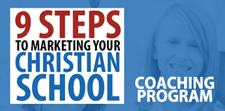
A while back, I did a post called, “100 Marketing Things To Do 100 Days Before School Starts” (link below). Now that school is back in session, it’s time for a similar post but focused on retention. Because the worst thing you want is to go through all of the trouble to get a new family, only to find out that they have drifted away without even knowing it.
Learn more retention ideas here.
Many of you know that I often talk about the 3 Rs of school marketing:
- RECRUITMENT
- RETENTION
- REFERRALS
There’s a way to look at RETENTION as “re-recruiting” – and I think there is a lot of validity to that interpretation because just because you have a new family seated at your school, there is certainly no guarantee that they will remain a student until they graduate. The odds are in your favor that they will, but you must show INTENTION about RETENTION.
Get ideas now about STOPPING THE DRIFT.
In the first 100 days of school, here is a list of the 5 most critical things to do in terms of re-recruiting families:
- Tell stories – continue writing blog posts, recording podcasts, and shooting videos that tell your school’s micro-stories.
- Follow up – depending on how many new families you had start this year, do your best to follow-up with each one within the first 100 days. If you started school mid-August, then Thanksgiving should be your target. A phone call is best, but an email will suffice. Even a face-to-face at a football game or in the pick-up line would work well (you can be intentional on spotting those families in the parking lot and getting a read on them pretty quickly – if you perceive a problem, invite them to a follow-up phone call or face-to-face conference).
- News and information – one of the hardest things about being a new family is learning the ropes in a new school. A continuous “out of the loop” feeling is hurtful to your re-recruiting efforts. Consider a bi-weekly “New Family” e-newsletter where you can inform them about various traditions around Homecoming, different class schedules on 1/2 days, or specific cut-off dates for High School spring mission trips.
- Leadership touch – invite new families to have coffee with the head of school once a month to talk about the school or shoot a bi-weekly video from your principal talking about a few key items for new families to take note of during the upcoming month.
- Handwritten note – this is so much easier than most schools say it is. If you have 100 new students, then the head of school can start writing one note per day (or batch process 7 of them every Monday morning). Or if you are already 75 days into the 100 days, split the list of new families up by key leadership. Give 10 to the Elementary principal, 10 to the Middle School principal, 10 to the High School principal, another 10 to the Athletic Director, Fine Arts Director, Spiritual Life Director, Admissions Director, teacher, board member and finally, give 10 to a seasoned parent. You could even rotate among this group throughout the year, and a new family could end up getting notes on a monthly basis from someone at your school. Powerful, huh?
In talks on lead generation (growing the pool of potential families), I will always argue that it costs a lot less TIME and MONEY to keep a family (re-recruit them) than it does to initially recruit them. So do not rest on your laurels and assume re-enrollment is a piece of cake. Get after it!
Again, show INTENTION about RETENTION!

Link: “100 Marketing Things To Do 100 Days Before School Starts“
If you are looking for someone to come alongside you this year to help you in your recruitment, retention, and referrals, I would love to talk with you about that. I only take a few new clients each year. I have room for one more to start in 2018. Click here to begin the conversation.


School is back in full swing! Your to-do lists are piling up and there is a great buzz on campus of a variety of different activities, not counting all the academic work!
Independent/private Christian schools need to think more about differentiation. This is what will set you apart in the marketplace. This will help you distinguish your school from other private nonsectarian schools as well as the public, charter and home school options around you.
Here are 7 activities that most schools do in the fall and an idea or two of how to optimize these activities in marketing your Christian school:
- Homecoming – because I live in Texas, Homecoming is always going to be in the fall although some schools I’ve worked with do it in conjunction with a winter or spring sport if they do not have football. At your Christian school, consider how Homecoming is different than at the public schools. While in Texas we have the crazy tradition of Homecoming mums (here’s an extreme example), your school may choose to do something in lieu of mums (traditional Texas mums can cost hundreds of dollars, which some students may choose to donate to a charity instead). Also, because your school likely smaller than your public school counterpart, you can recognize alumni differently, have alumni prayer gatherings before the Friday night game, and so much more. Homecoming can be a special event, but ask yourself: how different is what we do than our public schools around us? Carrying over some traditions is fun (HOCO dress-up days) but if you do not do anything unique, it might be worth looking at your annual traditions differently. Differentiation is critical to marketing.
- Grandparents Day – many elementary school across the country host a day for grandparents to come and visit the classroom and share a meal with their grandkids at their school. Again, if you’re school is smaller, perhaps you can do a special musical program or a performance by all of the students in elementary. Certainly you could involve your grandparents in a time of worship and prayer since you are not restricted by that like your public school colleagues are.
- Athletics – Cross Country, Volleyball, and Football are the most common fall sports, although your school may have others. How does your school differentiate itself at these sporting events? Do you pray before or after the game? Do you learn to integrate Scripture into your training of your athletes? Do you treat athletic training in the broader context of discipleship? How do you communicate striving for excellence but also enjoying the love of God? One school I worked with many years ago had an idea to launch a video series called, “The Making of a Kingdom Athlete.” They were already talking about spinning off a blog series and using the combination of written word and video to create vignettes to share with future families. The way you treat athletics should be noticeably different than the public schools.
- Fine Arts – whether it’s band on Friday night or some of the upcoming holiday performances (Veterans Day, Thanksgiving and Christmas), Fine Arts is a beautiful way to showcase your students’ talent. While you may lament that the size of Fine Arts program/facilities/equipment, how can you use your size to an advantage? Often at the large pubic school performances, there are limited solos. But at a smaller school, you can have more. While you still want to feature excellence, think of the different ways you can showcase individual talent. Your larger competitors simply cannot do that. This is an easy way to stand out.
- Annual Fund – most public schools do not have to have Annual Funds because they are funded by government sources. However at most privately-funded schools, the Annual Fund is a tool to bridge the gap between tuition revenue and the actual costs of school operations. The Annual Fund is a fundraising event, but it can be a great way to highlight the community aspect of your school. While outsiders may view it as a purely fundraising event, you can gather people together to pray for God to provide for the gap that exists. It also gives you plenty of opportunity to talk about some of the things your school is wanting to have in areas of facilities, technology, and safety. It provides a great platform to talk about the important things while future families listen in!
- Assessment – every school tests students, but it’s the government-mandated standardized testing that causes angst in parents and their kids. Often accused of “teaching to the test”, your private school does not have to abide by the same government standards (this is why it can be a great marketing tool for you). However, you can certainly talk about how you use benchmarks to assess your students’ academic progress (here’s how Eastern Christian talks about the difference). Parents do not like curriculum that is driven solely by a standardized test, however they want an excellent academic preparatory program. Use this differentiator to showcase you strong your academics are.
- Holidays – with Halloween, Veterans Day, Thanksgiving, and Christmas, your schedules are full of holidays. Many Christian schools avoid Halloween (many public schools do as well), but you can showcase how you still have fun with various dress up days. Veterans Day is a great way for you to gather Veteran parents and grandparents for a celebration on your campus or you may want to ask to have your middle school or high school choir sing for veterans at a community-wide celebration. Because of the spiritual nature of Thanksgiving and Christmas (and how such spiritual connotation has been virtually removed from the public square), you should make sure and showcase your performances that talk about how you are “grateful to God” or in the context of celebrating the birth of Jesus.
This article is not meant to list out a thousand innovations – the point is to recognize that it is the way that your school treats the common factors is how future families will tell there is something different about you. Look for ways to take the commonly-shared experiences the public schools have and turn them into great marks of differentiation. Also, use this as a test to determine if you are any different than your competing private schools in the area. If you cannot find much difference, how do you expect a future mom or dad to find you unique?
I love helping schools create plans and strategize about reaching future families. If I can help you, please click here to schedule a 30-minute free phone consultation to learn about my coaching program specifically designed for Christian schools.

Randy Vaughn, Christian School Marketing Consultant

As you look at a new school year starting, your enrollment management team is finally able to take a breath and “relax”. Unless you are a school with locked-in enrollment numbers by the spring, you have hard at work all summer long, emailing, calling, and following up with those last-minute families who might enroll in the fall. While some of you with open enrollment may continue to see a few late-comers, for the most part, your admissions team finally gets to experience “summer”.
As you evaluate your enrollment status, here are few things to consider. First, let’s take a look back.
LOOKING BACK
- Assess your Advertising: did that magazine ad drive anyone to your school? Did your radio…direct mail…social media campaign impact your numbers? While there are some difficulties in assessing some of the effectiveness of each one, you should at least acknowledge if something is worth doing for next year. Now is the time to evaluate, especially if you can provide any hard data to support your decision. Inevitably, a board member will approach you next spring wondering “why aren’t we doing that radio campaign again like we did last year? I thought that was brilliant!” If it didn’t work, then you’ll want data to show said board member.
- Self-Evaluation: take some time to evaluate yourself and your team. Where did you work from a place of strength? Where could you reallocate resources? Where do you need to spend more time? Less time? Hopefully your team can have an honest assessment so you don’t just start the treadmill over again in a few months without looking for ways to improve.
- Survey Says: consider reaching out to your new families and surveying them about their enrollment experience. Ask them about how they heard about you. Ask them to evaluate your admissions process. Ask them to give you candid feedback about your campus: appearance, communication, processes, etc. You can certainly do the same to your returning families, but these new families have the freshest eyes to see things most clearly.
LOOKING AHEAD
- Retreat: if possible, get away from the office for at least one day for an off-site retreat (two days or more would allow you time to go even deeper). If you haven’t done any self-evaluation, this is the place to do it. But this is also a time to spend some moments reflecting with gratitude for your new families. Before you get too critical about processes, and before the onslaught of next fall’s admissions season begins, take time to be thankful for who came your way this year. You might even take a few minutes to write a few hand-written cards to some of your new families. Have some fun together and do some team development work.
- Plan Quarterly: look at the new 3 months. If you are reading this in August, pretty much examine your school calendar, the national calendar (holidays, cultural rhythms, etc.), and your community/city calendar and see what is ahead. This will likely take you to Thanksgiving, so if you need to go ahead and plan through Christmas break, do so. Included in this timeframe is likely the start of next year’s enrollment season. It may begin with re-enrollment efforts in December or early in the new year (hint: don’t wait to start re-marketing to your families….that begins now!) Look at your social media planning calendar and know what’s ahead in the next few months and get a jump on scheduling some posts on Facebook or using a tool like Grum for scheduling Instagram posts. Here’s a free social media/marketing content planning calendar that has helped many.
- Mind the Gap: you should be able to have a hard count for each grade as you start the new year and see where the enrollment gaps are. This should give you real clear direction for next year. Is this year’s Kindergarten class small? While you certainly want to work hard at getting better Kinder numbers next year, you might also look at ways to grow next year’s 1st grade class so that you can set yourself up for a strong future. If you project Middle School to be down, then start concentrating your efforts now on developing a strategy for filling those seats.
Don’t get too busy now too look back and to look ahead.
SUCCESS STORIES
I love to help schools with their marketing, especially at this time of in the school calendar. I have been helping one school this past year that saw a 16% increase and another school who told me yesterday that they are almost 25 students more than they thought they would have when the board set the budget last spring. I would love to help your school as well!
Contact me for a free phone consultation – I am eager to help!

Randy Vaughn, Christian School Marketing Consultant

Over the years of working with Christian schools around the country, we have worked with schools from early childhood only to PK12 schools. In doing so, I have worked with schools in a variety of ways. Sometimes it has been a few short months of social media coaching, graphic design or website projects, or our longer year-long consulting projects.
One of the things I really enjoy doing is spending a day with a school during a School Marketing Workshop. As a matter of fact, one of the first ways we ever helped schools was with a one-day workshop back over a decade ago which resulted in the school’s first enrollment growth in a long time.
Recently, I had the opportunity to work with Cornerstone Christian in Sweetwater, Texas. We did a one-day workshop on a Saturday and it was so much fun! Stephanie Baker, Director, said this:
“We loved your presentation…. It was very informative and helpful. It was just the booster shot that we needed to get started and it was presented in such a way that gave us a clear starting place.”
You might wonder what all can really be accomplished in a single day workshop? Here are the key components we covered at the School Marketing Workshop in Sweetwater:
- Came to an agreed definition of school marketing so that the entire team could rally around one idea of what marketing is, allowing this definition to act as a filter for future projects, spending and focus.
- Discovered the 3 most important areas when developing a relationship with a future family. These are 3 key components to the above definition and help focus a school on marketing the right way.
- We examined the full scope of school marketing, looking at the very early stages of new awareness all the way to cultivating family referrals. There are many steps in this process, and while complex, it is not complicated. We examined the 3 Rs of school marketing: recruitment, retention and referrals.
- We also explored the differences and essential elements of having a system, a strategy and a tactical marketing plan. We looked at the differences in those terms and how each one builds upon another.
- We went through a pretty extensive exercise in determining what an “ideal family” looks like in terms of marketing. If you do not have a clear focus of who you are marketing to, it’s easy for your communication to be for the masses, and thus, likely resonate with no one. We explored the components of a targeted ideal family category to help focus our communication, brand, and marketing messages.
- We looked at the 6 most common lead generation tactics. Lead generation is necessary as your school enlarges the pool of potential families. Most of the time, the challenge in marketing a school is that too few people even know you exist. Expanding this pool to more possibilities is a strong key to enrollment growth.
We spend several hours brainstorming as a large group, then in table groups to determine specific action steps. While a good part of the morning of a School Marketing Workshop is understanding strategy, we do spend hours working together on at least a workable tactical action plan.
So that’s an overview of how a School Marketing Workshop could help your school.
Use the contact form here to ask about details. Typically the workshop is around $2000-2500 along with some travel expenses.
Let’s talk! Sign up at our contact form here to get started.
Randy Vaughn

Randy Vaughn, Christian School Marketing Consultant














